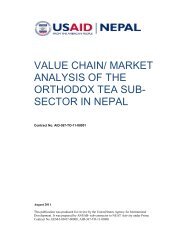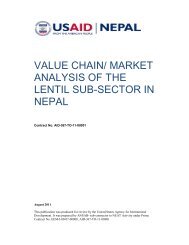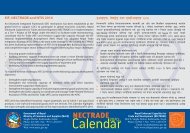value chain/ market analysis of the ginger sub-sector ... - Nepal Trade
value chain/ market analysis of the ginger sub-sector ... - Nepal Trade
value chain/ market analysis of the ginger sub-sector ... - Nepal Trade
- No tags were found...
Create successful ePaper yourself
Turn your PDF publications into a flip-book with our unique Google optimized e-Paper software.
long time. However, in recent years, especially in 2009, <strong>the</strong> export <strong>of</strong> <strong>ginger</strong> from China to<strong>Nepal</strong> has dramatically increased. The following table presents <strong>the</strong> export trend <strong>of</strong> <strong>ginger</strong>from China to <strong>Nepal</strong>. The <strong>ginger</strong> from China is mostly fibreless and is neatly cleaned, waxed,and properly packaged. The price <strong>of</strong> Chinese <strong>ginger</strong> is also comparatively higher than <strong>Nepal</strong>i<strong>ginger</strong>.Table 8: Export <strong>of</strong> Ginger from China to <strong>Nepal</strong>YearsExported quantity, Exported <strong>value</strong>, Exported unit <strong>value</strong>,MTUSD 1,000USD/MT2001 50 40 8002002 0 0 -2003 1,548 484 3132004 215 118 5492005 321 156 4862006 30 26 8672007 208 235 1,1302008 1,613 937 5812009 6,110 3,578 586Source: ITC 2010, CoM<strong>Trade</strong> 2010Ano<strong>the</strong>r country that <strong>Nepal</strong> imports <strong>ginger</strong> from is India. The quantity <strong>of</strong> <strong>ginger</strong> importedfrom India is small compared to China. However, <strong>the</strong> imported unit <strong>value</strong> from India to <strong>Nepal</strong>is relatively high compared to what <strong>Nepal</strong> exports to India. The following table presents <strong>the</strong>scenario <strong>of</strong> imported quantity, <strong>value</strong>, and unit price <strong>of</strong> <strong>ginger</strong> from India to <strong>Nepal</strong> in <strong>the</strong>period <strong>of</strong> 2001 to 2009.Table 9: Export Trend <strong>of</strong> Ginger from India to <strong>Nepal</strong>YearsExported quantity, Exported <strong>value</strong>, Exported unit <strong>value</strong>,MTIn USD 1000USD/MT2001 15 9 6002002 32 20 6252003 107 65 6072004 120 53 4422005 5 4 8002006 189 225 1,1902007 68 87 1,2792008 15 15 1,0002009 186 241 1,296Source: ITC 2010, CoM<strong>Trade</strong> 20102.6.2 Domestic Consumption and PriceOn average, about 25 to 30 kg is consumed by <strong>the</strong> producing households. 85 percent <strong>of</strong> <strong>the</strong>total production is estimated to be <strong>market</strong>ed by <strong>the</strong> producers ei<strong>the</strong>r as fresh new rhizome ormo<strong>the</strong>r rhizomes after maintaining <strong>the</strong> stock for next year plantation. The producers retain30-35 percent <strong>of</strong> <strong>the</strong> total production for seed purpose but at <strong>the</strong> later date part <strong>of</strong> this stockagain enters <strong>the</strong> <strong>market</strong> (CADP, 2008). Ginger is consumed in most <strong>of</strong> <strong>the</strong> households asspices. Some domestic manufacturers including pharmaceuticals use <strong>ginger</strong> in <strong>the</strong>ir products.Ginger is also one <strong>of</strong> <strong>the</strong> main ingredients for pickle industries in <strong>Nepal</strong>.Value Chain/Market Analysis-Ginger 14






